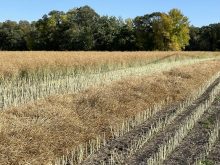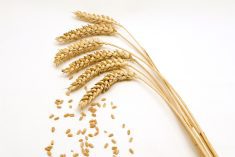A new checkoff on grain deliveries might be a fairer way to fund the Canadian Grain Commission (CGC), says assistant chief CGC commissioner Jim Smolik.
But he is open to suggestions.
“I think the simplest is a dealer point deduction,” Smolik told Winter Cereals Manitoba’s annual meeting March 12. “Is there a better model, something that you guys see as fairer?”
As of last Aug. 1 the CGC, the government-mandated grain-sector watchdog and protector of Canada’s grain quality brand, is required by law to be self-funded.
Read Also

Seeding Indigenous agricultural prosperity
National Circle for Indigenous Agriculture and Food says Indigenous agricultural success needs strong relationships.
Currently about $40 million or two-thirds of the CGC’s average annual $60-million budget comes from the $1.82 a tonne charged for outward inspection on about 23 million tonnes of grain exports. That represents just a third of Canada’s annual grain production, Smolik said.
“We don’t have someone we can hand that bill to (for other CGC services) so it has forced us to kind of off-load a lot of our costs on that outward inspection,” he said.
“Two-thirds of the grain is receiving CGC value for virtually no cost,” he said. “How do we make sure everybody pays for the benefit they are receiving from the CGC, whether it’s the Canada brand or grain safety?”
Fairer approach
Other fees cover 27 per cent of the CGC’s budget. The remaining nine per cent or $5.4 million comes from the federal government to cover benefits the CGC provides to Canada for such things as grain safety.
Some grain companies and farmers want mandatory CGC outward inspection, which guarantees Canadian grain meets customers’ specifications, made optional. Fewer outward inspections would cut CGC revenue.
While it’s grain companies that pay most CGC fees, it is believed much of the cost is passed back to farmers. But no matter who pays, clearly the burden now is on exported grain.
Besides the CGC’s “Certificate Final” issued on Canadian grain exports, CGC services include grain safety, monitoring, grain quality research, market access, dealing with grain customer complaints, export statistics and a program to protect farmers when grain companies don’t pay.
The CGC isn’t sure making outward inspection optional will save much money, Smolik said.
“We’ll likely have to be overstaffed because we’ll never really know when we’ll be called upon to do (inspect) a vessel,” he said. “We can’t impede business.”
If outward inspection was optional the CGC would have to train third-party grain inspectors and certify them to comply with requirements under the Canada Grain Act, he said.
From the Grainews website: Guenther: Farmers’ cash flow concerns feeding wide basis
Buyer complaints
The change could also hurt trade. A buyer might reject CGC inspection leaving Canada more vulnerable to phytosanitary complaints launched by the importing government, Smolik said.
“Ultimately the most important thing is country customer satisfaction,” he added. “So whatever we do we don’t want to impact the Canada brand.”
Some countries, such as Japan, will continue to insist on CGC inspection “for the foreseeable future,” he said.
Smolik noted the CGC has introduced more flexibility to outward inspection. Now it will certify to buyers’ specifications rather than just CGC grades if a buyer requests that. Composite sampling is another option.
“We’ve added a bunch of options… to help facilitate trade for whatever the countries want,” Smolik said.
There is a long list of issues to consider if the CGC were to change its funding model, Smolik said. One is whether to collect a checkoff in Eastern Canada where the CGC does not license primary grain elevators or provide farmer security on delivered grain.
Eastern grain accounts for five to seven per cent of Canada’s average total grain crop of 70 million to 80 million tonnes, Smolik said.
It’s unclear whether the CGC could collect a checkoff directly or whether it would have to hire another agency, he said.
It’s also unknown if that revenue could flow directly to the CGC or be collected by the federal government and then paid to the CGC.















